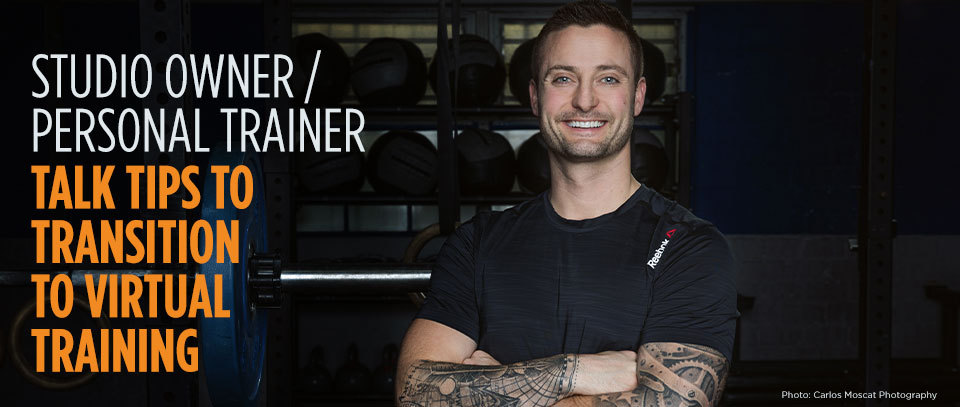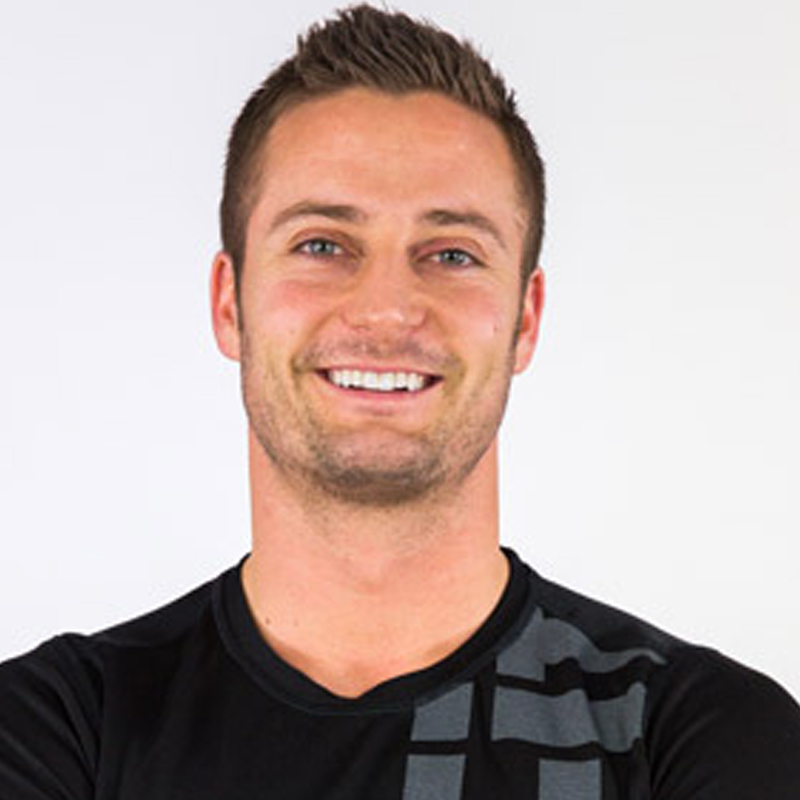PJ Stahl, M.S. is a personal trainer and creator of the fitness program Sweat Equation. He owns an independent training studio and group fitness gym called Project Steel in Los Angeles, CA. When the COVID-19 pandemic forced his studios to close their doors for an unknown period of time – he joined all of his fellow fit pros all over the world in the mission to take one-on-one and group training online.
Elisabeth Fouts holds a B.S. in Exercise Science and has over 15 years of experience in the fitness industry from a personal trainer & group fitness instructor to regional level fitness management. She is a PowerWave Master Trainer and holds industry group fitness certifications with ACE & Les Mills. Elisabeth serves as the Education Coordinator for Power Systems and is their primary content contributor for blogs and articles on a variety of subjects from personal training and group fitness programming to product spotlights and health club operations.
What follows is a breakdown of the discussion topics covered in our Instagram LIVE Interview entitled Studio Owner / Personal Trainer Talk Tips to Transition to Virtual Training.
GETTING THE WORD OUT
Q: What was the very first thing you did when you knew you were going to have to close the doors to both your studios, indefinitely?
A: The very first thing we did was notify our members, in every way we could. We sent personalized emails, we texted, we called, then we posted on social media. We wanted our members to hear it from us first and fast.
GETTING STARTED WITH DIGITAL TRAINING
Q: What were the first steps that you took when you realized you were going to have to close for a period of time?
A: Fortunately, we were already in the process of filming content for our online training app that we intended to launch this summer. Recent events forced us to shift gears and launch the online program early – so we were able to start promoting that new platform immediately, complete final preparations, and launch it within a week of closing our studio doors.
Q: If you don’t have a training app or online program in place, what are some recommendations to get one started?
A: There are several platforms such as Uscreen, VHX on Vimeo, or TrueCoach.
Q: Many people have already started the transition to online training using free meeting apps such as Google Hangouts, Zoom Meetings, Facebook/Instagram Live, etc. Without an app, what is the best way to start streaming classes / training sessions?
A: All of those are great options – don’t worry about the setting, if you are in your living room, basement, garage, or back porch. People don’t care about that right now – they understand. They just want the content. The benefit to hosting a ZOOM meeting is that it requires you to send out a unique meeting link and access code – in order words – these group sessions can be private – exclusive to the members that are either still paying their member dues at this time or are paying a ‘per class’ rate for virtual training.
If you are using ZOOM or another virtual meeting program that requires you to email out unique login or access info – post a schedule in advance letting people know what times LIVE classes / meetings will be hosted. If you use mind/body or another check in app – they can sign up for the class there and you can email them the meeting link when it is available. If you don’t use a check in app, just ask them to email you the classes they want access to and when the link is available for the meeting, you can send it over.
MUSIC & LICENSING
Q: Many instructors and trainers that have been hosting LIVE workouts or posting workouts online with music playing from their favorite playlists – are getting flagged or pulled down because they don’t ‘own the rights’ to the music. Where can people get music that is okay to play in the background of their workouts?
A: The easiest way to avoid this is to film without music. Tell your viewers to turn on their own music at home and follow along with you. That is the quickest, cheapest way to ensure that your content won’t be pulled from the social platform. There are streaming music platforms that many people are already using in fitness classes such as YES! Fitness Music that are okay to use. However, most of those songs have lyrics which can be distracting to you as you are filming or to your viewers trying to follow along. You can purchase a license to generic fitness music with great beats and tempos that have no lyrics.
The most important thing to remember when you license music is that you have to assign that song to the project – every time you use the song.
For example – if I have purchased the license to a song called, “Fit Fuel”, and I intend to play it during an Instagram live 7 minute workout on Friday, March 27, at 12PM PST – I have to assign that song to that project and that time. However, if I intend to use it again in another project – something I’m recording for my training app – I have to assign it there as well. The reason is that is how artists get paid by how many times their songs are used. So as fitness PROFESSIONALS we also need to respect music industry PROFESSIONALS and use their music appropriately.
FREE CONTENT VS. PAID CONTENT
Q: So many people are posting free workouts and content right now – how do you then transition back to asking people to pay for your service when you’ve been offering it for free?
A: That is a GREAT QUESTION. The most important thing to remember right now is DON’T GIVE EVERYTHING AWAY FOR FREE! Long term, it devalues your service as a fitness professional – and paying members might cancel their subscription if they can see that they can get plenty of content for free from you. However, it is a good idea to give teasers or previews of what a paid service from you would be like.
For example, on my Instagram page for my training app Sweat Equation – I post a FREE 7 MINUTE workout everyday “THE SWEATY 7” and it is accessible to everyone. These are bodyweight workouts that are great to get people moving – but I don’t post entire 20-minute(+) workouts in videos or in written programming because that service is specialized and should be reserved for clients and members that subscribe to a paid service.
PROGRAMMING: TIME
Q: Have you noticed that there is a certain time of day that tends to be best for your live streams?
A: 9AM PST/12PM EST is a good time for the lunch workout crowd on the east coast. 5PM PST/8PM EST has been good for the west coast folks to log in. However, feel free to poll your client base and ask for their preferred times to workout live. Or maybe set up your online class meeting schedule to match up with the same times you’ve been offering classes in your studio. I also recommend posting it on your IG TV as a video people can access and use anytime. That way if they miss the live workout they can do it later at their own convenience and feel like they didn’t miss out.
Q: When transitioning to online training, what is a good length of time for a session?
A: 60 minutes might seem like an eternity to a member working out in a small space, not moving around a circuit, or moving from one piece of equipment to another across the gym. It also might seem like an eternity to you as their trainer. For class structure I recommend shifting to 10, 20, or 30-minute formats. For 1-on-1 personal training I recommend doing 25 or 50-minute sessions. If you do that, you might also consider shifting your payment model to 50-60% of your normal hourly rates.
PROGRAMMING: EQUIPMENT
Q: Are all of your workouts programmed exclusively with bodyweight exercises – or do you implement any equipment?
A: Bodyweight exercises are the primary movements in the free, teaser workouts that I offer. However, one of the ‘selling points’ of offering a paid, online personal training service is that a client has the opportunity to send you a list of the equipment they have access to so that you can build a program that utilizes what is available to them. If a paying client doesn’t have equipment but wants to purchase equipment, you can assist them by providing them a few lists of suggested pieces, at various budgets and price ranges, so they can choose how much they want to invest.
PROGRAMMING: QUALITY
Q: How do you shoot your content videos?
A: Everything I do is shot with my smartphone. I have a tripod for it so I can set it up steadily at different angles and vantage points.
Q: Do you have any advice for someone looking to take their ‘paid’ online training options to the next level – to show a clear and immediate upgrade in the paid vs. free content?
A: When I shoot content for my online program, or for my paying clients – I have a microphone that I use that connects to my phone that tremendously improves the audio content of the digital sessions. I film that content with my mic on but with no music. Depending on the project, I can go back and add the music later -or- with the better quality audio of my voice, it is easier for clients to play their own music at home and still hear and understand me clearly.
Q: Is there a microphone you would recommend?
A: I am using the MIC-J HEADSET from JK GLOBAL TRADING LLC. Then I use the RODELink wireless transmitter to connect the mic to my phone for the shoot. This will help with the quality of audio and value of your videos.
Follow Power Systems and PJ Stahl on Instagram for more!



You must be logged in to post a comment.